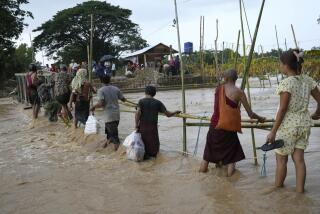Major Bangladesh Rivers Start to Recede : But Threat of Epidemic Remains; at Least 21 Million Homeless
- Share via
RAJBARI, Bangladesh — This country’s three mightiest rivers began receding Tuesday, but the most urgent problem grew: how to provide food, shelter and clean water to at least 21 million homeless people and prevent an epidemic.
“This is the worst flood in the history of Bangladesh,” President Hussain Mohammed Ershad said to about 300 men, women and children huddled in front of him on a narrow embankment surrounded by brown water.
A soldier doled out scoops of uncooked rice, and Ershad told the people more food would be found.
Floods have submerged three-fourths of the country in the last 10 days, and 12 smaller rivers were reported still rising Tuesday, although the Ganges, Brahmaputra and Meghna receded. The flooding began in June with the monsoon season, then abated and resumed last month.
1,154 Reported Dead
At least 412 people have died since June, according to government figures, but that number is considered too low. Daily death reports in Dhaka newspapers, including 32 people who drowned when a ferry sank in the Pabna district 75 miles west of the capital, put the total at 1,154.
Illness from flood-polluted water is increasing. The government health control center reported 10,000 new cases of diarrhea Tuesday, bringing the total to 102,000, and said 79 people had died of it. Those totals include only cases in areas that still can communicate with Dhaka.
Information Minister Mahbubur Rahman said Sunday that 21 million people were homeless.
A Region of Deltas
Bangladesh is a region of deltas for rivers that carry floodwaters down from the Himalayas during the annual monsoon rains. Erling Dessau, head of the U.N. Development Program, said: “There should not be 110 million people living here. I think nature should have been left to itself.”
The government says it is too early to assess total damage or how much money will be needed for food supplies and reconstruction. Ershad said during a tour of flooded areas by helicopter and launch, however, that the cost of restoring roads and rail lines alone will be 5 billion takas ($156 million).
3 Million Tons of Grain
He and other government officials have said Bangladesh needs 3 million tons of grain from abroad. “We will have to feed the people for two months at least,” Ershad said in a brief chat with reporters during the tour Tuesday.
Floods came at the worst time for food production in Bangladesh, which was East Pakistan until 1971. It became independent after a civil war in which India supported the rebels. Half its annual production of 16.5 million tons of rice was in the ground when rice paddies across the country were inundated.
Bangladesh has three rice-growing seasons each year, but the current one normally produces the most, and the projected yield had been 8 million tons. The government says at least 2 million tons will be lost.
The United States has committed nearly $3.6 million to Bangladesh flood relief, the U.S. Agency for International Development said Tuesday. Disaster management experts will be sent to Dhaka to help assess the situation and advise on further assistance, the agency said.
More to Read
Sign up for Essential California
The most important California stories and recommendations in your inbox every morning.
You may occasionally receive promotional content from the Los Angeles Times.













